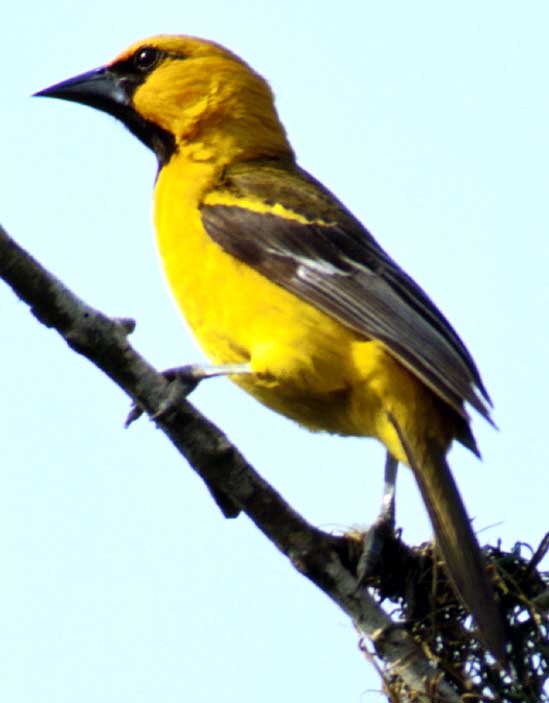- Altamira Oriole
Taxobox
name = Altamira Oriole
status = LC | status_system = IUCN3.1

regnum =Animal ia
phylum = Chordata
classis =Aves
ordo =Passeriformes
familia =Icteridae
genus = "Icterus"
species = "I. gularis"
binomial = "Icterus gularis"
binomial_authority = (Wagler, 1829)The Altamira Oriole, "Icterus gularis", is a
New World oriole . The bird is widespread in subtropical lowlands of the Mexican Gulf Coast and northernCentral America , the Pacific coast and inland. It also can be found in the extreme south ofTexas , (locally called theRio Grande Valley ).At 25 cm and 56 grams, this is the largest oriole of the "
Icterus " genus. This bird nests in open woodlands. The nest is a very long woven pouch, attached to the end of a horizontal tree branch, sometimes to telephone wires.This bird forages high in trees, sometimes in the undergrowth. They mainly eat
insect s and berries.These birds are permanent residents, and unlike the migratory orioles that breed in the US, the species is "sexually monomorphic" -- both the males and the females have elaborate coloration and patterning.
References
* Database entry includes justification for why this species is of least concern
Further reading
*Brush, T. and Barbara Y. Pleasants (2005). "Altamira Oriole (Icterus gularis)". The Birds of North America Online. (A. Poole, Ed.) Ithaca: Cornell Laboratory of Ornithology; Retrieved from The Birds of North American Online database.
* Flood NJ. (1989). "Coloration in New World Orioles 1. Tests of Predation-Related Hypotheses". Behavioral Ecology & Sociobiology. vol 25, no 1. p. 49-56.
* Gorena RL. M.S. (1995). "Feeding and nesting ecology of the great kiskadee, Pitangus sulphuratus texanus (Passeriformes: Tyrannidae) in the lower Rio Grande Valley, Texas". The University of Texas - Pan American, United States -- Texas.
* Hathcock CR. M.S. (2000). "Factors affecting reproductive success in hosts of the bronzed cowbird (Molothrus aeneus) in the lower Rio Grande Valley, Texas". The University of Texas - Pan American, United States -- Texas.
* Hathcock CR & Brush T. (2004). "Breeding abundance and nest-site distribution of the Altamira oriole at Santa Ana National Wildlife Refuge, Texas". Southwestern Naturalist. vol 49, no 1. p. 33-38.
* Ortiz-Pulido R. (2000). "Abundance of frugivorous birds and richness of fruit resource: Is there a temporal relationship?". Caldasia. vol 22, no 1. p. 93-107.
* Pleasants BY. (1981). "Aspects of the Breeding Biology of a Subtropical Oriole Icterus-Gularis". Wilson Bulletin. vol 93, no 4. p. 531-537.
* Thurber WA & Villeda A. (1980). "Notes on Parasitism by Bronzed Cowbirds Molothrus-Aeneus in El-Salvador". Wilson Bulletin. vol 92, no 1. p. 112-113.Hybridisation
* Patrikeev, Michael, Jack C. Eitniear, Scott M. Werner, Paul C. Palmer (2008) Interactions and Hybridization between Altamira and Audubon's Orioles in the Lower Rio Grande Valley "Birding" 40(2):42-6
External links
* [http://ibc.hbw.com/ibc/phtml/especie.phtml?idEspecie=9731 Altamira Oriole videos] on the Internet Bird Collection
* [http://vireo.acnatsci.org/search.html?Form=Search&SEARCHBY=Common&KEYWORDS=altamira+oriole&showwhat=images&AGE=All&SEX=All&ACT=All&Search=Search&VIEW=All&ORIENTATION=All&RESULTS=24 Altamira Oriole photo gallery] VIREO-(with pictures of hanging bird nests)
Wikimedia Foundation. 2010.
